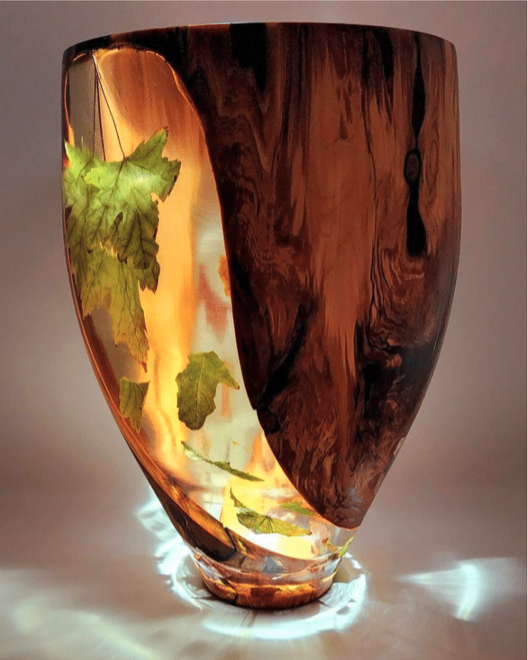Dan Preece is a hobbyist woodturner who loves to take on new challenges using carefully selected wood, finished with resin to produce beautiful art forms using a Laguna Revo 18|36 Lathe. This finished piece is a great example of Dan’s work, as it includes a tall narrow form of cedar with a spectacular grain pattern, coupled with crystal clear resin, and an assortment of leaves in both summer and fall form to represent the changing seasons.
Dan follows a careful process to ensure the resin is used efficiently and to bring out the beauty of the natural materials used in the piece.

Start with a sketch. Dan starts this project by capturing his vision on paper, which helps him anticipate important details before beggining, and also gives him an opportunity to experiment with different ideas before locking in on his final design.

Mount up a nice chunk of wood. Dan had been saving this special piece of gnarly cedar for a couple years for the right project. He started by mounting the piece between centers on his lathe, finding the best point of balance on this heavy piece. He leaves the bark in place as this comes off naturally during the turning process.

Rough shape. Dan starts by carefully turning the piece into its rough shape. To maintain the balance of a heavy chunk of wood like this, it will be spun slowly at first to not cause too much vibration on the lathe. Speed can be gradually increased as the piece becomes more balanced and less heavier. Notice the formation of the tenon, which will be used to mount the piece into a four jaw chuck to give greater control over the piece for the remaining portions of turning.

Sketch design onto the wood. Now that the piece is roughed out to its general shape, Dan uses his drawing as a guide and begins to sketch the shape onto the wood. This will serve as a guideline for removing material to create a “window” into the vase.

Rough out the “Window” using an Angle Grinder and Sanders. After Dan finalizes his sketch on the piece, he used an angle grinder and various sanding tools to remove the stock and smooth out the lines to create a refined opening that will be filled with resin.

Prepare for resin. An important step in the process is to create a form or sleeve that will help contain the resin as much as possible. Dan used some durable plastic sheathing from a home center to carefully wrap the piece to prevent all of the resin from oozing out before it cured.

Mix and pour resin. Dan used a two part resin to create the window on this project. In addition to the plastic form that he created around the piece, he cleverly set the piece into a plastic bag and surrounded it with sand to further constrain the resin. The blank was then placed in a vacuum chamber for an hour to set the resin deeply into the wood and to help remove bubble pockets trapped in the wood. Then it was left to cure in a pressure pot, which removes bubbles from the resin and produces a clear window. Dan uses a metal container so that the piece can be easily transferred between the vacuum chamber and pressure pot without disturbing the resin.

Resuming turning. After the resin cured, Dan mounted the piece back onto the lathe using a four jaw chuck, and turned right through the plastic sheathing that served as a form.

Hollowing out the piece. Dan started the hollowing using a forstner bit, followed by using carbide turning tools to remove the rest of the material. Dan explains the trade-offs of doing this, as opposed to using a turning tool for all the hollowing. The forstner bit removes stock quickly, but if you skip that step and go directly to turning tools, you can use the tailstock to support the piece as you turn, giving you greater stability.

Use light to determine wall thickness. Dan uses the LED light on his lathe to help keep tabs on the wall thickness. With suspended material in the resin it’s important to not turn the walls so thin that the leaves begin to emerge, or worse, that the piece becomes unstable.

Apply a finish. Dan used Teak Oil to bring out the natural beauty of the cedar, and to give the piece a lustrous glow.
This piece, along with everything that Dan makes, was donated to artforour.org to help fight child trafficking. If you would like to see more details of this process, and see more great content from Dan, check out his YouTube channel.




